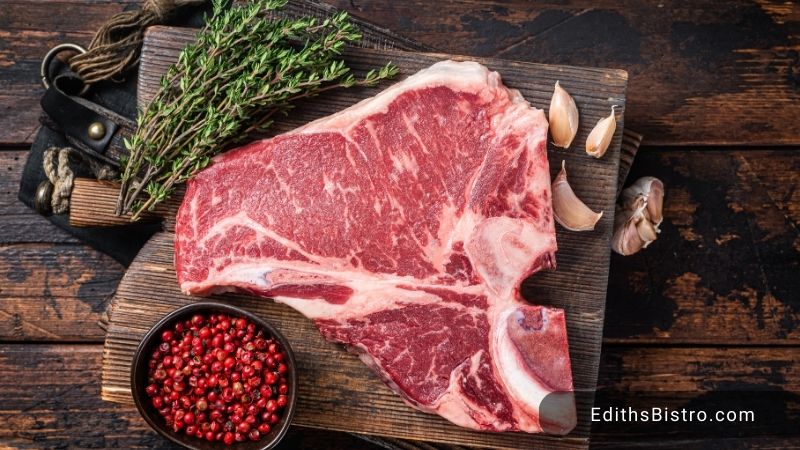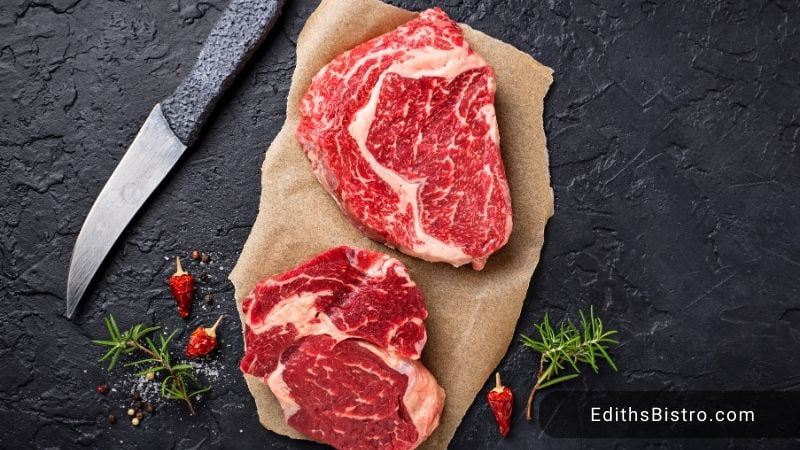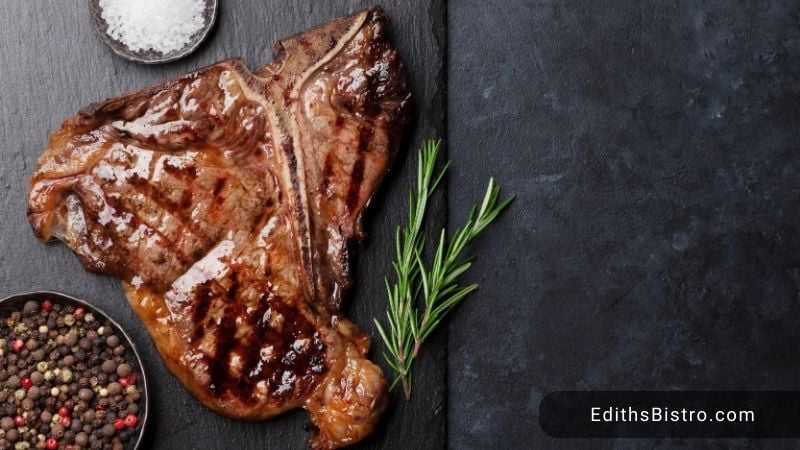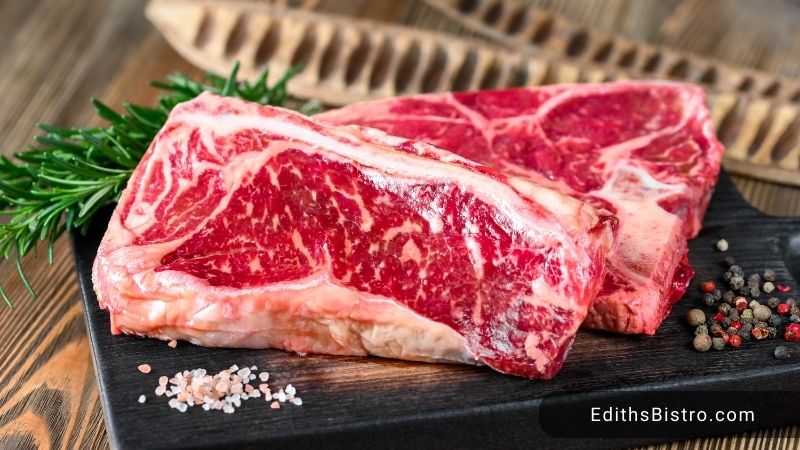When it comes to selecting the perfect steak, two cuts often stand out – the Porterhouse steak vs Ribeye. Both are iconic in their own right, boasting unique characteristics that have made them favorites among steak lovers. But how do they fare against each other?
Porterhouse Steak Vs Ribeye: Key Differences
The Porterhouse and Ribeye differ in several key aspects – primarily regarding location on the cow, structure, and fat content.
Porterhouse steak is a composite cut from the short sirloin, including 2 parts – the tenderloin and strip steak. Ribeye, hailing from the rib section, delivers a rich, marbled texture.
| Aspect | Porterhouse | Ribeye |
|---|---|---|
| Location on cow | Short loin | Rib section |
| Structure | Two-steak-in-one | Single muscle cut |
| Fat content | Moderate | High |
What steak is better ribeye or porterhouse?
The answer to this question is highly subjective. If you’re someone who enjoys a tender, lean steak with a balanced flavor, Porterhouse is the way to go. However, if you love a rich, fatty steak with a robust flavor, Ribeye would be a better choice.
Is porterhouse more tender than ribeye?
Yes, the tenderloin section of the Porterhouse is one of the most tender cuts of beef. However, the ribeye, due to its high-fat content, provides a juicier steak.
Porterhouse steak vs ribeye taste-wise
The Porterhouse steak is a fascinating blend of two distinct tastes. On one side, you have the tenderloin – a soft, tender cut with a mild flavor. Picture biting into a buttery, melt-in-your-mouth piece of steak. That’s your tenderloin.
On the other side, you have the strip steak – a firmer cut with a more robust, beefy flavor. Imagine a steak with a beefy punch that leaves a lasting impression on your palate. That’s your strip steak.

Contrastingly, the Ribeye steak delivers a consistent, rich, and beefy flavor throughout. Thanks to the abundant marbling (the fat interspersed within the muscle), every bite is juicy, delivering a burst of flavor that fills your mouth.
Think of a symphony orchestra where each instrument (or in this case, each morsel) contributes to a harmonious, flavorful performance.
In essence, choosing between a Porterhouse and a Ribeye is like deciding between a duo of musicians and a full orchestra – both are unique experiences that cater to different taste preferences.
Porterhouse steak vs ribeye price-wise
The price of both Porterhouse and Ribeye steaks can vary significantly based on factors like the quality of the beef (Prime, Choice, Select), the size of the steak, and where you purchase them.
As of 2023, on average, a USDA Prime Porterhouse steak might cost around $16.99 per pound at a butcher shop or a high-end grocery store. You might find more affordable options at local supermarkets or wholesale clubs for around $11.99 per pound.

Comparatively, a USDA Prime Ribeye boneless steak might set you back around $22.99 per pound at a similar high-end outlet. More economical options could cost you around $15.99 per pound at a local supermarket or wholesale club.
Remember, these are average prices of Porterhouse steak vs Ribeye. The actual costs can fluctuate based on factors like the specific store, the region you live in, the time of year, and the current demand for beef.
Regardless, in most scenarios, you’ll find that Ribeye tends to be more expensive than Porterhouse due to its rich marbling and robust flavor.
Porterhouse Steak Vs Tomahawk
While both are show-stoppers, the Tomahawk is a bone-in Ribeye with a long rib bone and is known for its dramatic presentation. Porterhouse, with its two different cuts in one, offers a more diverse flavor profile.
Porterhouse Vs T-Bone
Think of Porterhouse and T-Bone steaks as siblings – very similar, yet each with their unique qualities (See the detailed comparison between T-bone and ribeye). Both these steaks are cut from the short loin area of a cow and include two different types of meat separated by a T-shaped bone (hence the name T-Bone). On one side of the bone, you have the tenderloin, and on the other side, you have the strip steak.

Imagine you and a friend are sharing a pizza. You get a larger slice with more toppings, while your friend gets a smaller slice with fewer toppings. That’s essentially the difference between a Porterhouse and a T-Bone.
The Porterhouse is like your pizza slice – larger and with more of the tender, buttery tenderloin section. On the other hand, the T-Bone is like your friend’s slice – smaller and with less of the tenderloin.
In conclusion, if you’re someone who can’t get enough of the tenderloin’s buttery goodness, the Porterhouse would be your go-to choice.
However, if you’re more into the beefy flavor of the strip steak and wouldn’t mind a smaller piece of tenderloin, the T-Bone would serve you well.
What’s The Best Cut Of Steak? Steak Lovers Voted!
When it comes to the coveted title of “Best Cut of Steak,” preferences can vary widely. Some steak enthusiasts may lean towards the buttery tenderness of a filet mignon, while others may prefer the robust, beefy flavor of a ribeye. However, according to a 2023 survey conducted by the American Meat Institute, one cut stood out among the rest.

The Ribeye steak took the top spot, with 37% of the respondents naming it as their favorite cut of steak. The high-fat content, rich marbling, and beefy flavor of the Ribeye won over the taste buds of the majority.
Coming in second was the New York Strip, favored by 24% of the survey participants. The Porterhouse, with its unique combination of tenderloin and strip steak, followed closely at 22%.
The filet mignon, known for its tenderness, rounded out the top four with 17% of the votes.
These results underscore the diversity of steak lovers’ preferences. The “best” steak cut truly depends on the individual’s taste, making the world of steaks a delicious realm of personal discovery.
Where To Buy Porterhouse And Ribeye?
The quest for the perfect Porterhouse steak vs Ribeye can lead you to multiple destinations. Here’s where you can find these premium cuts:
- Local Butcher Shops: These are perhaps the best places to buy steaks. Local butchers often have high-quality, freshly cut steaks and can provide expert advice on selecting and cooking your steak.
- Supermarkets: Most supermarkets have a meat section where you can find a variety of beef cuts, including Porterhouse and Ribeye. While the quality might vary, supermarkets offer convenience and competitive pricing.
- Online Meat Providers: Companies like ButcherBox, Omaha Steaks, or Crowd Cow deliver high-quality steaks right to your doorstep. These sources offer a wide range of options, including grass-fed and organic beef.
- Wholesale Clubs: Stores like Costco or Sam’s Club often sell bulk packs of Porterhouse and Ribeye steaks at a lower cost per pound than other outlets. The trade-off might be that you’ll have to buy a larger quantity.
- Farmers Markets: If you’re looking for locally sourced, organic, or grass-fed options, farmers markets can be a great choice. Not all markets will have these cuts, but it’s worth checking out.
Remember, the best place to buy your steak depends on what’s most important to you – price, quality, convenience, or a specific type of beef.
Cooking A Porterhouse Vs Ribeye Steak – Steakhouse Secrets!
Cooking a Porterhouse steak is all about balancing the two different cuts. Start by bringing the steak to room temperature. Season simply with salt and pepper. Grill or broil on high heat, searing each side for about 4-5 minutes.
Then, move it to a lower heat area and cook to your preferred doneness. The goal is to get a nice crust on the outside while keeping the tenderloin from overcooking.
To cook a Ribeye steak, start with room-temperature meat and simple seasoning. Pan-searing is an excellent method for Ribeye. Heat a cast-iron skillet over high heat with a bit of oil.
Sear the steak on one side for about 4-5 minutes until a crust forms, then flip and cook the other side to your preferred doneness. The high heat helps to render the fat, enhancing the steak’s flavor and creating a delicious crust.
Remember, with Porterhouse steak vs Ribeyes, let them rest for a few minutes before slicing to allow the juices to redistribute.
Tips On How To Bring Out The Differences Between Porterhouse And Ribeye Steak
Porterhouse Steak:
- Cooking: Use a two-zone grilling method to handle the two different cuts in a Porterhouse. The tenderloin cooks faster than the strip steak, so position the strip side closer to the heat source.
- Seasoning: Keep it simple with coarse sea salt and freshly ground black pepper to let the dual flavors of the steak shine through.
- Side Dish: Match the Porterhouse with a classic baked potato and a dollop of sour cream. The mild potato complements the complex flavors of the steak.
Ribeye Steak:
- Cooking: Pan-searing works extremely well for Ribeye. The high heat renders the fat, creating a flavorful, crispy crust.
- Seasoning: A mix of salt, black pepper, and a dash of garlic powder can highlight the rich, marbled flavor of the Ribeye.
- Side Dish: Pair the Ribeye with a fresh, crisp salad. The acidity and crunch of the greens balance the rich, fatty Ribeye.
Remember, the key to highlighting the differences between Porterhouse steak vs Ribeye lies in understanding their unique characteristics and tailoring your cooking method, seasoning, and side dishes accordingly.
FAQs
Is porterhouse better than ribeye?
It’s subjective. Porterhouse offers a two-in-one steak experience, while Ribeye delivers a consistently rich flavor.
Is porterhouse a cheap steak?
No, Porterhouse is a premium cut, but typically less expensive than Ribeye.
What is a poor man’s ribeye?
That’s a chuck eye steak, located near the ribeye, offering a similar flavor, but at a lower cost.
References
- T-bone steak: https://en.wikipedia.org/wiki/T-bone_steak
- Rib eye steak: https://en.wikipedia.org/wiki/Rib_eye_steak
- Beef, short loin, t-bone steak, separable lean and fat, trimmed to 0″ fat, all grades, cooked, broiled: https://fdc.nal.usda.gov/fdc-app.html#/food-details/169464/nutrients






![What To Pair With Quiche? 25+ Best Dishes [With Pictures]](https://www.edithsbistro.com/wp-content/uploads/2024/04/what-to-pair-with-quiche-160x90.jpg)
